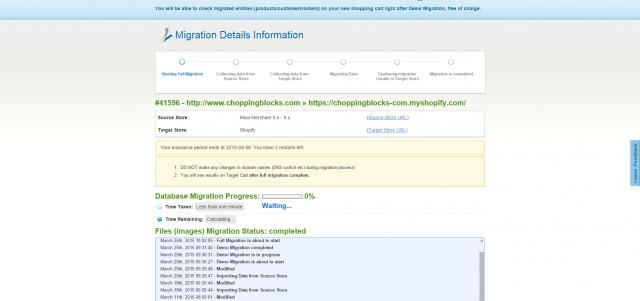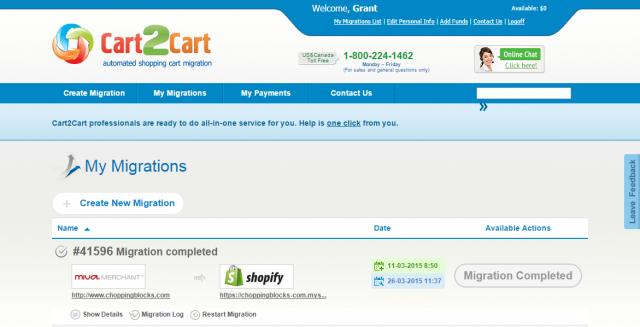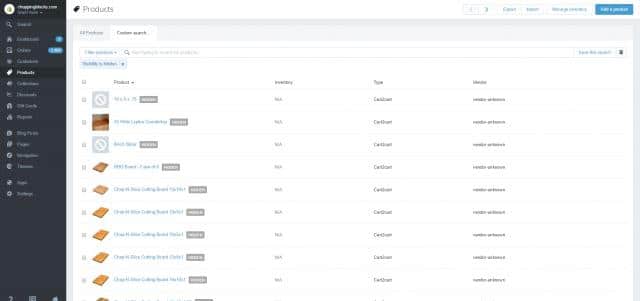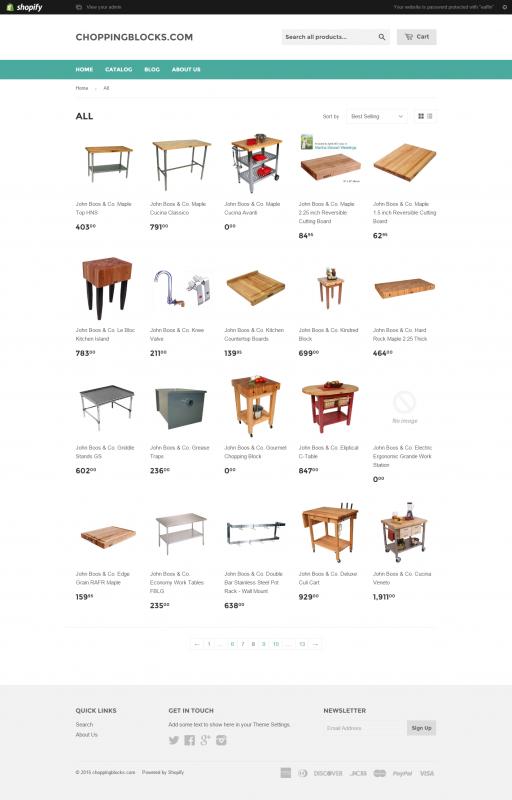Day 5: How to Migrate from Miva Merchant to Shopify
Caption Contest – How not to do a cart migration?
Sales to Date: $155.56
Yesterday I talked about why I chose Shopify over BigCommerce for our new ecommerce platform for ChoppingBlocks.com. Today, I'll be walking through migrating our store from Miva Merchant 9 over to Shopify. Why am I just a little scared? Because I'll be moving over 2,493 historical orders, 374 products, over 2,000(!) variants, dozens of categories and untold custom fields and module configuration settings.
Or in English, I'm attempting to perform an engine swap between an old American muscle car and German sports car, with the added bonus that the engine is welded to the frame. What could possibly go wrong? You'll have to find out.
As a technical and business person, anytime there is a task that can be automated, I am all for it. Manual labor should be the last possible resort to get things done, although there is always a time and place for it. I answer phone calls for my stores while they are incubating, because it helps me learn my products. When I am looking to migrate my store however, there is nothing to be gained by doing it by hand. Even the idea of manually moving thousands of settings over makes me die a little on the inside.
Lesson 15: Your time is valuable. If you can delegate for the right price, do it. Even if it's not the right price, you should probably do it.
A little bit of Googling led me to Shopping-Cart-Migration.com which predictably specialized in shopping cart migrations. I liked that they had a demo option and at ~$150 for the migration, it would certainly be cheaper than hiring an outside developer. The site built trust with me because it obviously specialized in nothing but migrations in addition to building software specifically for many open source ecommerce platforms (Zen Cart, Open Cart, Virtue Mart, X-Cart and OS Commerce).
Jumping in, the instructions for exporting data out of Miva were fairly easy, though I ran into issues with uploading the data, as it claimed some of the files were not working properly. After some back and forth with support, they were able to fix the files and I was able to begin the demo migration.
The problem with any migration is that no matter what, the more customized your site is, the more problems you are going to have. ChoppingBlocks.com is highly customized and had a gang of options intended to work with Search Spring, which provides faceting and product filtering (a highly important part of online shopping). I know intuitively that most of these settings simply are not going to be able to moved over to Shopify and that I'll have to re-invent the wheel in some ways.
On the other hand, doing this migration myself will provide me the opportunity to become very familiar with Shopify and explore the limits of the system, as Shopify doesn't have faceting or product filters out of the box either.
So, I swallowed hard and started the migration.
While the migration was happening, I took the time to really explore Shopify and play around and see what was available. I didn't add or delete any items as that would have caused issues with the migration I imagine, but it gave me time to figure out what would likely not get moved over.
As you can see, 2.5 hours later, my migration was completed. I was biting my nails by this time because I really wanted to see how things turned out over on Shopify's end.
Just so we are clear though, what I'm migrating over to Shopify is all of my store data, but my live store is still running on Miva and operational. You never, ever take down a live store to perform a migration – you only switch stores when you are 100% sure that your new store is operational.
Lesson 16: When possible, use live servers and development servers when developing or modifying a store. This prevents you from accidentally blowing up your store and losing sales.
Logging into Shopify, one of the first things you can see here is that I've got near all 2,493 orders imported and I'm seeing a lot of “Hidden” items on my products page. Apparently there were a lot of products I didn't realize were not showing on Miva merchant, so this was a rather interesting surprise.
One by one, I went through each major data point and made a mental note of whether the migration succeeded or not:
- Orders: Successful import
- Customers: 70% success, with order dates that didn't match up to orders and double orders showing up
- Products: 70% success: Pictures, descriptions, pricing (mostly) and SKUs ok, but categories and vendors failed to migrate. Most importantly, the variants came through, but none of the custom fields or data.
- Collections: Shopify's version of categories; these came in ok
- Coupons: Nope
- Pages: Nope
- Blog: Nope
So, all in all, for the $160 I paid for the migration, it saved me quite a bit of time, though I'll need to go through and fix quite a few things by hand. I'm also going to take a page from Andrew's great post on how not to screw up a cart migration over at Ecommerce Fuel. He recommends using outsourced help and virtual assistants for much of the manual labor and I think that would be a fantastic idea for punching in product data and filtering variables. If I can pay someone else a $4 an hour for data entry, that would make my life much better in this next week.
As a baseline, here's how my site is looking on a default Shopify template post-migration:
It's not terribly pretty, but most things are in here. So, my goal now is to try and fix all the errors and then start classifying products into their proper collections and categories and get my product filtering up and running. Once that is done, then I can work on making the site more appealing. Luckily, Shopify has some great out of the box templates that will make my life easy while I bootstrap the site into something hopefully much bigger.
Are you thinking of a Shopify migration or have done one already? How did it go? Let us know!
This post is part of How to Run a Chop Shop, a real life blog series on attempting to turn around a struggling ecommerce store into a profitable online business in 365 days.








Are you up for some mentoring? I would love to pick your brain about some things in the Ecommerce world! I have 2 live sites one producing early 6 figures, but stagnate in growth, I am looking on how to take it to deep 6figures by years end. and I have a very new site that is setup 80% and Its running on auto pilot for the most part and sales are starting to grow completely organically. It helps that that site is a URL based off a growing brand in our industry, The kicker is I have another URL that is a established brand already and it may grow even faster organically but I am wanting to go self hosted or with a good store provider and I hate Big commerce as they kicked me off for speaking bluntly about them. I have my eye on shopify, but it does not feel right and i hate not having my own SSL.
I would love to have some advice and back and forth with someone who knows what i am talking about all my friends and business associates here have no clue about Ecommerce and all i get a blank stares haha.
Thanks for articles they are facinating
Jon
Hey John,
Sorry for the late reply, but I remember reading your earlier post about the issues you were having with BC and switching over to 3D Cart. As the technical guy of the team, I’ve certainly done a fair amount of research before opting for BigCommerce and now Shopify. It’s not easy deciding which one to pick.
We’re pretty pressed for time these days (as you can see by the recent lack of updates), but if you’re looking for consulting help, send me an email at grant@tactical.com and I’ll see what we can work out. It sounds like you have a pretty interesting project, so maybe we can even do a case study.